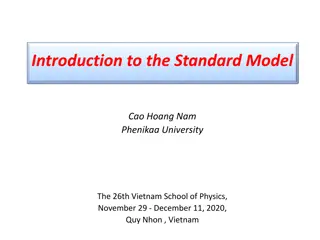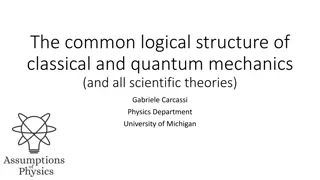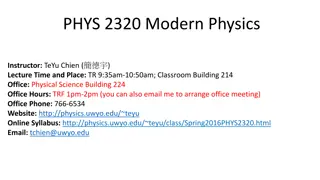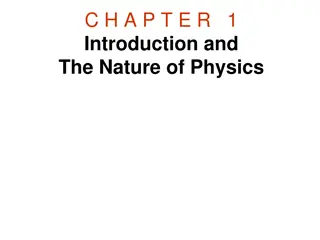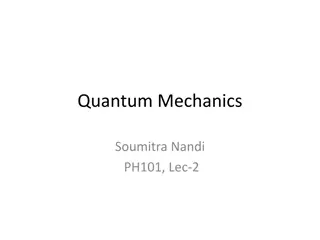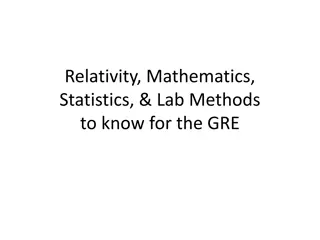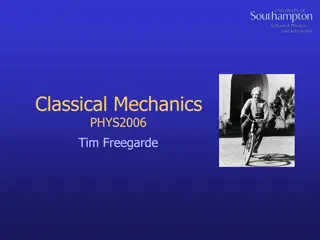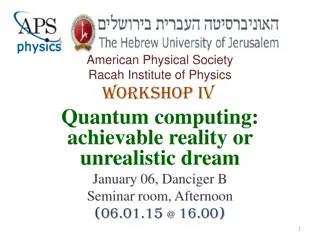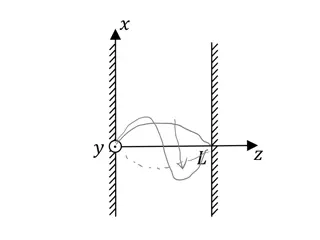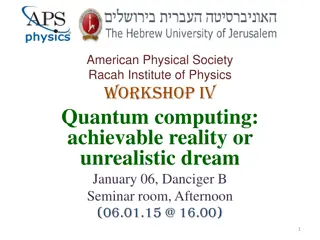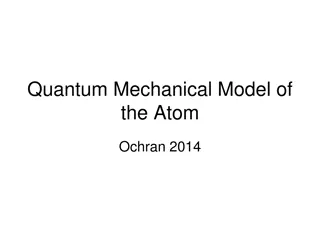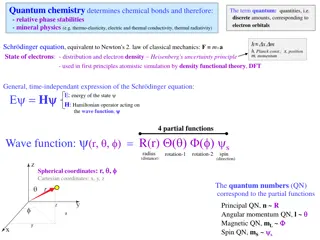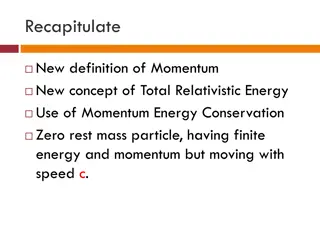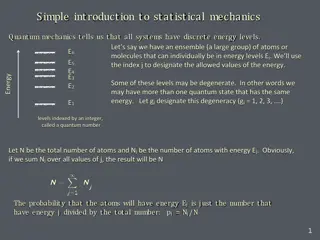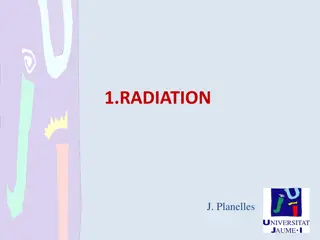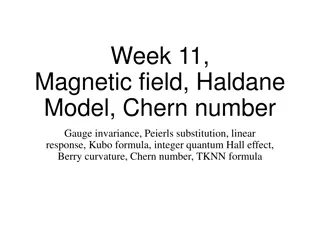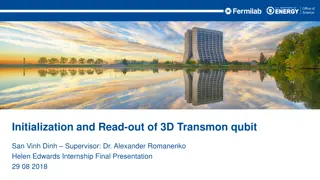Exploring Physics: From Classical Mechanics to Relativistic Quantum Mechanics
Physics, derived from Greek meaning "nature," encompasses the study of the laws governing the universe at all scales. Classical physics delves into mechanics, thermodynamics, electricity, and optics, while modern physics covers atomic, nuclear, and particle physics. Relativistic Quantum Mechanics combines relativity for high speeds and quantum mechanics for small objects. The field also delves into measurements, units, significant figures, and their role in calculations.
Download Presentation

Please find below an Image/Link to download the presentation.
The content on the website is provided AS IS for your information and personal use only. It may not be sold, licensed, or shared on other websites without obtaining consent from the author. Download presentation by click this link. If you encounter any issues during the download, it is possible that the publisher has removed the file from their server.
E N D
Presentation Transcript
Physics The word physics comes from Greek, meaning nature. The study of nature came to be called natural philosophy. Physics is the study of the laws of nature that govern the behaviour of the universe, from the very smallest scales of sub-atomic particles to the very largest in cosmology. It applies these laws to the solution of practical problems and to the development of new technologies. Physics can be divided into classical physics and modern physics. Classical Physics: Mechanics, Thermodynamics, Electricity and Magnetism, and Optics. Modern Physics: Atomic physics, Nuclear Physics, Particle physics, and Condensed-Matter physics. http://davidbrin.wordpress.com/2011/01/04/w hich-science-is-the-most-fundamental/
Relativistic Quantum Mechanics Modern physics: relativity (very fast) and quantum mechanics (very small). Relativity must be used whenever an object is traveling at greater than about 1% of the speed of light or experiences a strong gravitational field such as that near the Sun. Quantum mechanics must be used for objects smaller than can be seen with a microscope. The combination of these two theories is relativistic quantum mechanics, and it describes the behavior of small objects traveling at high speeds or experiencing a strong gravitational field. Relativistic quantum mechanics is the best universally applicable theory we have.
Measurements meter_ss.PNG 1. How many centimeters are there in a foot? (1 inch = 2.54 cm)
Length Measurement Ruler Vernier caliper Micrometer
Units http://physics.nist.gov/cuu/Units/index.html A physical quantity is a quantity that can be used in the mathematical equations of science and technology. A unit is a particular physical quantity, defined and adopted by convention, with which other particular quantities of the same kind are compared to express their value. SI base units: SI derived units: SI prefixes: Fundamental physical constants:
Significant Figures Determine the number of significant figures in the following measurements: a. 0.0009 b. 15,450.0 d. 87.990 e. 30.42 c. 6 103
Significant Figures in Calculations 1. For multiplication and division: The result should have the same number of significant figures as the quantity having the least significant figures entering into the calculation. 2. For addition and subtraction: The answer can contain no more decimal places than the least precise measurement
Significant Figures and Scientific Notation Light and Sound: Discussion What is the speed of sound and light? Speed of sound in air (at 200C) = 343 m/s Speed of light = 299792458 m/s Mean Earth-Sun Distance = 149600000000 m. How much time it take (in minutes and 3 sig. figures) for the sunlight to reach earth?
Units of Measurement System SI CGS BE Length Meter (m) Centimeter (cm) Foot (ft) Mass Kilogram (kg) Gram (g) Slug (sl) Time Second (s) Second (s) Second (s) SI stands for the French phrase "Le Systeme International d'Unitus." CGS - centimeter (cm), gram (g), and second. BE - British Engineering.
A The meter Earth AB 1 m In 1792 the meter was defined to be one ten- millionth of the distance from the north pole to the equator of the Earth. C 7 10 Equator B For practical reasons the meter was later (1799) defined as the distance between two fine lines on a standard meter bar made of platinum-iridium. In 1960, a new standard for the meter, based on the wavelength of light, was adopted. Specifically, the standard for the meter was redefined to be 1 650 763.73 wavelengths of a particular orange-red light emitted by atoms of krypton-86 in a gas discharge tube. Today (since 1983) the meter is defined as the length traveled by light in vacuum during the time interval of 1/299792458 of a second. This is because the measurement of the speed of light had become extremely precise. Speed of light: C=299792458 m/s
The second Initially the second was defined using Earth s rotation: 1 1 second 24 60 60 of the time it takes the Earth to complete a full rotation about its axis. The problem with this definition is that the length of the day is not constant as is shown in the figure. Since 1967 the second is defined as the time taken by 9192631770 light oscillations of a particular wavelength emitted by a cesium-133 atom. This definition is so precise that it would take two cesium clocks 6000 years before their readings would differ by more than 1 second.
Standard Kilogram Today The SI standard of mass is a platinum- iridium cylinder shown in the figure. The cylinder is kept at the International Bureau of Weights and Measures in Sevres, Paris and assigned a mass of 1 kilogram. Accurate copies have been sent to other countries. A Second Mass Standard: The masses of atoms can be compared with one another more precisely than they can be compared with the standard kilogram. For this reason, we have a second mass standard. It is the carbon-12 atom, which, by international agreement, has been assigned a mass of 12 atomic mass units (u).




